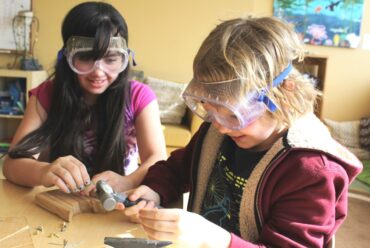Pillar Two: Consistency and Routine – Fostering Stability and Confidence
In the first pillar of our series on raising a well-adjusted child the Montessori Way, we laid the groundwork for setting up environments that nurture independence, confidence, focus, responsibility, a sense of belonging, and problem-solving skills. We emphasized the critical role of the environment in promoting these qualities, making emotional management easier for children when they feel supported and capable. Now, armed with the insights from our first pillar, you are better equipped to implement routines, consistency, and set clear expectations—the focal points of Pillar 2.
The second fundamental pillar of the Montessori philosophy aims to cultivate Basic Trust in children, a cornerstone for their well-being. Predictability that comes from well-established routines and consistency contributes to a child’s overall sense of stability and confidence which in turn fosters basic trust, a solid ground to build on. Basic trust in children minimizes anxiety and allows them to relax and settle into themselves, promoting a higher level of brain capacity for learning and reasoning. Here are some insights into how stability and confidence are integrated throughout the Montessori Philosophy.
-
Establish a Daily/Nightly Routine:
Create a consistent routine that includes key activities. For example, utilize calming bedtime routines, like taking a bath to signal the winding down of the day. Predictable schedule provides a sense of security for your child. Children tend to be calmer and more cooperative when they know what to expect. Here are examples of appropriate, consistent routines that increase children’s sense of stability and confidence:
- Morning Routine: Wake your child up about the same time every day to establish their sleep-wake cycle. Encourage them to participate in their daily hygiene; washing their face, brushing their teeth, and getting dressed. To build daily connection and a positive start, sit together for a nutritious morning breakfast. Include in your conversation plans or the schedule for the day, for example, Today is Monday. When you are done eating, I will take you to school. I will pick you up at 3:00. Consistently arriving to school each day, especially for toddlers and preschool age children, sets a positive tone for the day as they anticipate what lies ahead. This regularity helps them enter their environment feeling relaxed, confident, and prepared for their day ahead.
- Night Routine: Eat a family dinner together. Where possible let your child help with meal preparation, setting up the table and cleaning up. Guide them through their personal hygiene routine by taking a relaxing bath or shower and brushing teeth. Prepare the nighttime environment together by playing soft music, getting a soft blanket ready, and closing the curtains. Spending some quiet time together before bedtime, whether it is reading or engaging in a reflective conversation such as discussing highlights of the day, can give children a chance to feel loved and connected. This nurturing routine can help them unwind and prepare for a restful night’s sleep.
- Visuals: Create a visual chart showing morning and evening routines. Toddlers and Preschool children respond well to concrete and visual aids and can greatly benefit from pictures showing their routine activities. Adults can effectively encourage children to refer to these routine charts when they are distracted. Many Living Montessori parents, that have implemented visual aids, have reported that the charts have proven to empower children, help them self-manage and be independent, increase cooperation and minimize power struggle. Setting up a calendar together to mark significant events is extremely powerful in promoting a sense of ownership, which encourages cooperation. A visual calendar fosters a sense of security, minimizes uncertainties, and gives children an opportunity to look forward to favorable events. Examples of events that may be important for children include a parent’s absence and return date, family outings or vacation plans, start of school or summer camp, arrival and departure of visitors and birthdays. Keeping them simple ensures children are not overwhelmed with information.
-
Provide Structure with Flexibility:
At Living Montessori we recognize the importance of flexibility within established routines. Children are unique individuals with varying needs and preferences. It is important to note that the established framework emphasizes flexibility in choosing activities, exploring interests, and adjusting daily schedules based on evolving needs. Communicating the changes, when possible, and giving children time to process goes a long way in helping them feel secure. The key is to foster a balance between structure and individualization. Here are some ways to encourage a balance:
- Choices within limits Encourage your child to make choices within reasonable boundaries. For example, present a range of healthy snacks to choose from. Let them pick their outfit for the day from a selection of pre-approved options. Allow them to select their bedtime story. During meals, offer nutritious options and let them decide what goes on their plate. This approach empowers them to make decisions while maintaining consistency with established routines and expectations.
- Designate a Personalized Learning and Activity Space: Create a special area in your home for your child’s activities, whether it is a cozy reading corner or an art zone. Providing a designated space encourages personal exploration within their daily routine. Keep the space uncluttered, with purposeful activities that are categorized for easy clean up. Less is more. Incorporate tidying up into their daily routine ensuring all activities are returned to their assigned spots.
- Involvement in Planning: Involve and guide your child in planning daily activities. Their involvement not only promotes a sense of belonging but also empowers them to contribute and learn from making age-appropriate decisions.
-
Consistency in Expectations and Responses:
Consistency extends beyond routines to encompass expectations and responses. In our preschool and elementary program educators uphold consistent expectations for behavior and academic engagement. When children comprehend what is required of them and receive consistent responses to their behavior, they feel secure and self-assured. This consistency creates an atmosphere that allows children to explore, learn, and develop essential life skills with a sense of confidence and trust. Here are strategies to remain consistent in your expectations and responses:
- Set Clear Guidelines: Provide clear and consistent guidelines for behavior. For example, establish expectations for respectfully treating and caring for materials. You may need to show them how this is done. Show them ways of interacting with peers or family members. Set clear expectations for mealtime etiquette. for example, When eating dinner, you need to stay in your chair. If you get up, it means you are all done. If they do not remain seated, follow through by removing their plate and remind them that they made the choice, reassuring them that they can try again next time. Clear expectations, consistency, and follow through eliminate ambiguity, thus encouraging cooperation and self-regulation.
- Model Behavior: Finally, model acceptable behavior. We have all heard the saying, actions speak louder than words. Children learn most by observing others, so it is essential to demonstrate the same behaviors and attitudes we want to see in them.
To incorporate these principles into your parenting or teaching style, remember the following:
- Establish consistent daily routines that offer predictability and security. Provide visuals of routines for children ages 3 and up.
- Provide structure while allowing flexibility within the routine to accommodate individual needs and abilities.
- Set clear expectations and follow through consistently in your expectations and responses.
Children who live with clear expectations and guidelines, along with consistency and routine, are more likely to feel secure, confident, able to self-regulate, and be cooperative.
We sincerely hope this blog proves helpful in your parenting journey, enriching your life and making your time with your child more joyful. Our wish is that by implementing the strategies we have suggested, you will witness the transformative power of Consistency and Routines in nurturing a well-adjusted child. We encourage you to provide feedback on your experiences.
Citations
- Montelores Early Childhood Council – The Whole-Brain Child 12 Revolutionary Strategies to Nurture Your Child’s Developing Mind [PDF]
- Centers for Disease Control and Prevention (CDC) – Building Structure
- Sanford Health News – The power of consistency while parenting young children
- Living Montessori – Routine, Regularity, and Order Help Children Thrive
- Living Montessori – How to Make a Morning Routine Chart for Kids
- Living Montessori – 5 Pillars Of Raising Well-Adjusted Children The Montessori Way.







